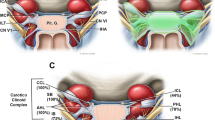Summary
The petrolingual ligament is the posteroinferior attachment of the lateral wall of the cavernous sinus, where the internal carotid artery enters the cavernous sinus. The petrous segment of the internal carotid artery finishes and the cavernous segment begins at the superior margin of this ligament. The ligament is surgically important due to its identification as a landmark for dissection of the internal carotid artery during the approaches to posterolateral intracavernous and extracavernous lesions. It can be well exposed after mobilization of the gasserian ganglion, or after the trigeminal root and ganglion have been split along the junction of V2 and V3 (the transtrigeminal approach). The petrolingual ligament was studied in five cadaveric head specimens from ten sides. The size of the ligament was measured, and its anatomical, clinical and surgical importance is discussed.
Similar content being viewed by others
Author information
Authors and Affiliations
Rights and permissions
About this article
Cite this article
Ziyal, I., Salas, E., Wright, D. et al. The Petrolingual Ligament: The Anatomy and Surgical Exposure of the Posterolateral Landmark of The Cavernous Sinus. Acta Neurochir (Wien) 140, 201–205 (1998). https://doi.org/10.1007/s007010050086
Issue Date:
DOI: https://doi.org/10.1007/s007010050086




